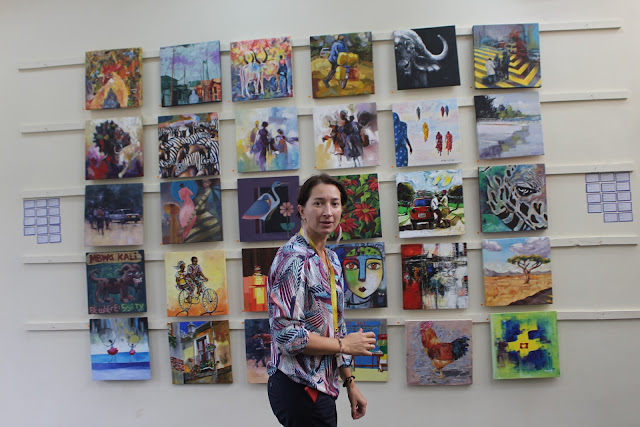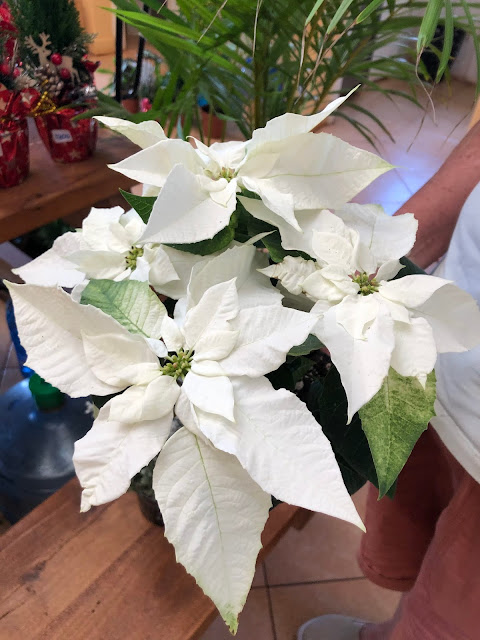By
Margaretta wa gacheru (posted 30th November 2019)
David Thuku
has been on the move from the moment I first met him in 2013.
He had
recently formed Brush tu Art Studio together with Boniface Maina and Michael
Musyoka, after having worked with them painting theatrical backdrops and home
murals with the two before that.
Thuku had already graduated from the Buru Buru Institute of Fine Art and won a Langalanga Scholarship, the British-based charitable fund that supported education opportunities for bright but ‘needy’ Kenyan youth. I remember vividly seeing his series on pregnant women and felt at the time, the works might be reflecting the artist’s own potential to give birth to new art forms that he had yet to see within himself.
Sure enough, Thuku’s art has developed and transformed many times since then. He has worked with a variety of mixed media, not just the painting that the ‘brush’ in ‘Brush tu’ had signified. When he won the competition to design the Kempinski’s new chandelier, I wasn’t surprised to see his colorful dangling rings which he’d carefully knitted together hanging gracefully from the light.
Thuku had already graduated from the Buru Buru Institute of Fine Art and won a Langalanga Scholarship, the British-based charitable fund that supported education opportunities for bright but ‘needy’ Kenyan youth. I remember vividly seeing his series on pregnant women and felt at the time, the works might be reflecting the artist’s own potential to give birth to new art forms that he had yet to see within himself.
Sure enough, Thuku’s art has developed and transformed many times since then. He has worked with a variety of mixed media, not just the painting that the ‘brush’ in ‘Brush tu’ had signified. When he won the competition to design the Kempinski’s new chandelier, I wasn’t surprised to see his colorful dangling rings which he’d carefully knitted together hanging gracefully from the light.
Thuku
remained a member of the Brush tu Collective even when he moved his studio from
Brush tu first to Kuona Artists Collective and then to the Kobo Trust. He’s
still based at Kobo now, but even before One Off Gallery recently made him a
new member of its group, he was exhibiting abroad in Paris, London and most
recently in South Africa.
Now that he
is having his first solo exhibition at One Off as one of the Gallery’s guys, I
can see why this show is called ‘Still In Motion’. It’s because Thuku is indeed
still gaining new insights, trying out new techniques and coming up with
fascinating and fresh ideas.
In his 2018
exhibition at Red Hill Gallery, Thuku’s work was slightly more political than
now, illustrating the challenge that consumerism poses in polluting people’s
minds. Even then he had begun working with paper-cuts and coming up with
thought-provoking art.
His show at
One Off seems less political and more of a reflection of ordinary people in
their everyday lives. With heads apparently insulated in boxes as they move,
his figures seem to be isolated in their own limited cocoons. Thuku himself
says the boxes signify something about identity and what people experience in
their psyche. But to me, the boxes suggest limitation and confinement to a
static worldview. Even though they seem to be in motion and walking across
differing terrains, still there is no interaction among his figures. Each one
is isolated, which suggests a condition related to an individualism that has
few relations with their fellow human beings.
Thuku also
creates paper cuts containing empty chairs in them. He suggests the chairs
signify expectation of visitors to come. But they could also signify emptiness
and a feeling of alone-ness in contrast to the community that people find among
family and friends.
Thuku’s collage paper-cuts are clean and refined, but I personally would like to understand their significance in terms of direction. Where are his figures going? Being in-motion for motion’s sake is like creating art for art’s sake. One wants to know the meaning of the work. Otherwise, it’s simply are left with an interesting technique, attractive color combination and so-called ideal body forms in Thuku’s figures. His technique is especially intriguing since he works in layered collage paper-cuts and glazed in acrylics.
Thuku’s collage paper-cuts are clean and refined, but I personally would like to understand their significance in terms of direction. Where are his figures going? Being in-motion for motion’s sake is like creating art for art’s sake. One wants to know the meaning of the work. Otherwise, it’s simply are left with an interesting technique, attractive color combination and so-called ideal body forms in Thuku’s figures. His technique is especially intriguing since he works in layered collage paper-cuts and glazed in acrylics.
We applaud Thuku
for exploring and experimenting with new techniques, but still, we wanted to understand
more about the significance of his art. It’s probably my inability to see.





















































